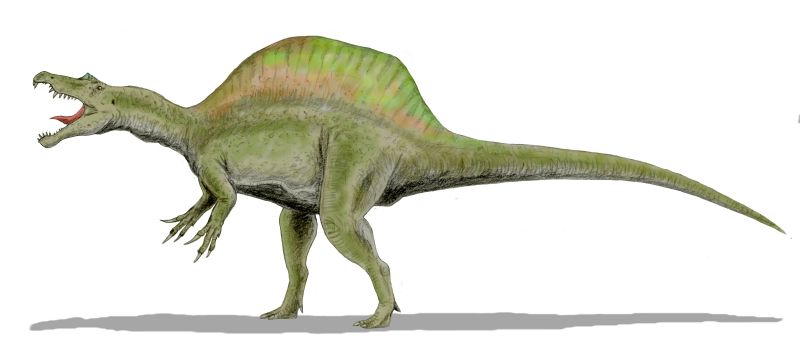- Spinosauridae
Taxobox
name = Spinosaurids

image_width = 250px
image_caption = Illustration of "Spinosaurus ".
regnum =Animal ia
phylum = Chordata
classis = Sauropsida
superordo =Dinosauria
ordo =Saurischia
subordo =Theropoda
superfamilia =Spinosauroidea
familia = Spinosauridae
familia_authority = Stromer, 1915
subdivision_ranks = Subfamilies
subdivision =
*Baryonychinae
*Spinosaurinae (type)
synonyms =
* Baryonychidae Charig & Milner, 1986
* Irritatoridae Martill "et al.", 1996Spinosauridae is a family of unusual
theropod dinosaur s. Members of this group were large,bipedal predators with elongated,crocodile -like skulls, sporting conical teeth with no or only very tiny serrations. The front dentary teeth fanned out, giving the animal a characteristic look. The name of this family alludes to the typically conspicuous sail-like structure protruding from the back of at least some species. The purpose of the sail is disputed, but popular explanations are that it may have served as a thermoregulator, a threat display, or as a sexual display during courtship.All spinosaurids appeared during the
Cretaceous period without ever, judging by the scarce findings, becoming abundant. Spinosauridfossil s have been recovered inAfrica ,Europe ,South America , andAsia .Taxonomy
The family Spinosauridae was named by
Ernst Stromer in 1915 to include the single genus "Spinosaurus". The family was expanded as more close relatives of "Spinosaurus" were uncovered. The firstcladistic definition of Spinosauridae was provided byPaul Sereno in 1998 (as "All spinosaurids closer to "Spinosaurus" than to "Torvosaurus ").Spinosauridae contains two subfamilies--Spinosaurinae and Baryonychinae. The subfamily Spinosaurinae was named by Sereno in 1998, and defined by Holtz "et al." (2004) as all
taxa closer to "Spinosaurus aegyptiacus" than to "Baryonyx walkeri". The subfamily Baryonychinae was named by Charig & Milner in 1986. They erected both the subfamily and the family Baryonychidae for the newly discovered "Baryonyx", before it was referred to the Spinosauridae. Their subfamily was defined by Holtz "et al." in 2004, as the complementary clade of all taxa closer to "Baryonyx walkeri" than to "Spinosaurus aegyptiacus".Classification
* Superfamily
Spinosauroidea
** Family Spinosauridae
*** ?"Chilantaisaurus "
*** "Suchosaurus "
*** Subfamily Baryonychinae
****"Baryonyx "
****"Cristatusaurus "
****"Suchomimus "
*** Subfamily Spinosaurinae
****"Irritator "
****"Angaturama "
****?"Siamosaurus "
****"Spinosaurus "Diet
Evidence shows that spinosaurids fed on fish as well as a variety of other small to medium sized animals, including small dinosaurs. "Baryonyx" was found with fish scales and the digested bones of a young "
Iguanodon " in its stomach cavity, one specimen of "Spinosaurus" had a fish bone lodged in one tooth socket, and there is one documented example of a spinosaurid having eaten apterosaur .Buffetaut, E., Martill, D., and Escuillié, F. (2004). "Pterosaurs as part of a spinosaur diet." "Nature", 430: 33.]References
Wikimedia Foundation. 2010.
